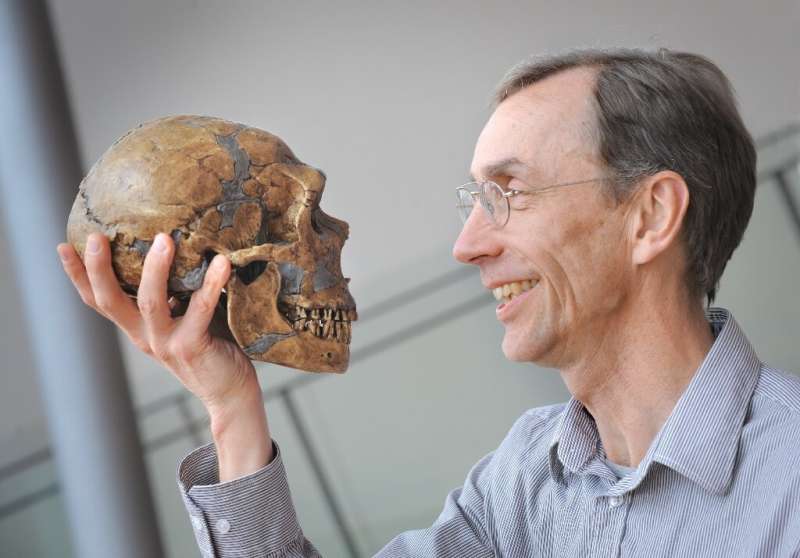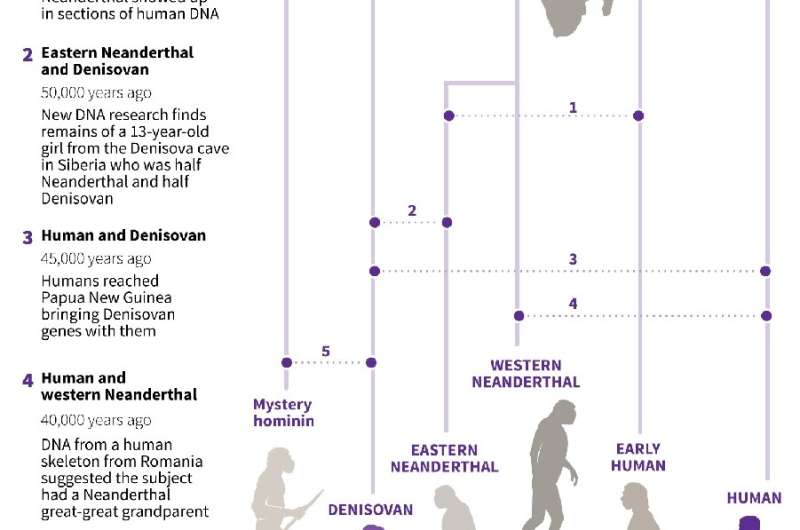Sweden's Paabo wins medicine Nobel for sequencing Neanderthal DNA

Swedish paleogeneticist Svante Paabo, who sequenced the genome of the Neanderthal and discovered the previously unknown hominin Denisova, on Monday won the Nobel Medicine Prize.
Paabo's research gave rise to an entirely new scientific discipline called paleogenomics, and has "generated new understanding of our evolutionary history", the Nobel committee said.
"By revealing genetic differences that distinguish all living humans from extinct hominins, his discoveries provide the basis for exploring what makes us uniquely human," it said in a statement.
Paabo—the founder and director of the department of genetics at the Max Planck Institute for Evolutionary Anthropology in Leipzig—found that gene transfer had occurred from these now extinct hominins to Homo sapiens following the migration out of Africa around 70,000 years ago.
"This ancient flow of genes to present-day humans has physiological relevance today, for example affecting how our immune system reacts to infections," the jury said.
One such example is that COVID-19 patients with a snippet of Neanderthal DNA run a higher risk of severe complications from the disease, Paabo found in a 2020 study.
Paabo told reporters he was surprised when the committee called to tell him he had won.
"At first I thought this is probably an elaborate prank done by people in my (research) group. But then it sounded a little bit too serious to me so I sort of accepted the fact", he said.
Paabo, 67, takes home the award sum of 10 million kronor ($901,500).
He is the son of Sune Bergstrom, a Swede who won the 1982 Nobel Medicine Prize for discovering prostaglandins—biochemical compounds that influence blood pressure, body temperature, allergic reactions and other physiological phenomena.
In his 2014 memoir "Neanderthal Man: In Search of Lost Genomes", Paabo wrote that he was conceived as a result of a secret extra-marital affair.
He later told The Guardian outlet that Bergstrom's "official" family knew nothing of his or his mother's existence, the Estonian chemist Karin Paabo, until 2005 after Bergstrom's death.
Paabo also wrote in his memoir that he "had always thought of myself as gay" until he met the woman who would become his wife, primatologist Linda Vigilant, who also works at the Max Planck Institute. He now identifies as bisexual.
Achieved 'the seemingly impossible'
Homo sapiens are known to have first appeared in Africa around 300,000 years ago.
Our closest known relatives, Neanderthals, developed outside Africa and populated Europe and Western Asia from around 400,000 to 30,000 years ago, when they became extinct.
That means that about 70,000 years ago, groups of Homo sapiens and Neanderthals coexisted in large parts of Eurasia for tens of thousands of years.

"The last 40,000 years is quite unique in human history in that we are the only form of humans around. Until that time there were almost always other types of humans that existed", Paabo told the Nobel website.
In order to study the relationship between present-day humans and extinct Neanderthals, DNA needed to be sequenced from archaic specimens with only trace amounts of DNA left after thousands of years.
In 1990, Paabo managed to sequence a bit of mitochondrial DNA from a 40,000-year-old piece of bone.
"For the first time, we had access to a sequence from an extinct relative", the Nobel jury said.
Comparisons with contemporary humans and chimpanzees showed that Neanderthals were genetically distinct.
Paabo then "accomplished the seemingly impossible", the committee said, when he published the first Neanderthal genome sequence in 2010.
It showed that the most recent common ancestor of Neanderthals and Homo sapiens lived around 800,000 years ago.
Paabo and his team were able to show that DNA sequences from Neanderthals were more similar to those from contemporary humans originating from Europe or Asia than those from Africa.
"This means that Neanderthals and Homo sapiens interbred during their millennia of coexistence," the Nobel jury said.
In modern day humans with European or Asian descent, around one to four percent of the genome originates from Neanderthals.
New addition to family tree
In 2008, Paabo and his team went on to sequence a 40,000-year-old bone fragment found in the Denisova cave in southern Siberia.
It contained exceptionally well-preserved DNA.
"The results caused a sensation—the DNA sequence was unique when compared to all known sequences from Neanderthals and present-day humans," the Nobel jury said.
Paabo had discovered a previously unknown hominin, given the name Denisova.
Comparisons showed the gene flow had also occurred between Denisovans and Homo sapiens.
In the same cave, palaeontologists later discovered the fossil of a young girl who was part Neanderthal, part Denisovan, proving the two species interbred.
Paabo's research proved that when Homo sapiens migrated out of Africa, at least two extinct hominin populations inhabited Eurasia—Neanderthals in western Eurasia, and Denisovans in the eastern parts.
More information: medicalxpress.com/news/2022-10 … arded-evolution.html
© 2022 AFP





















